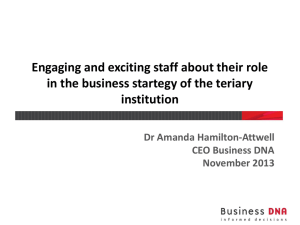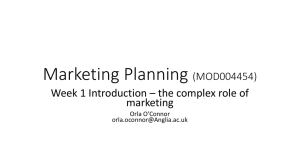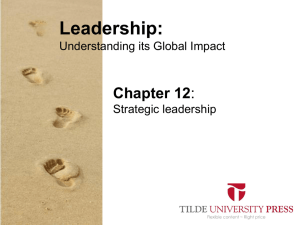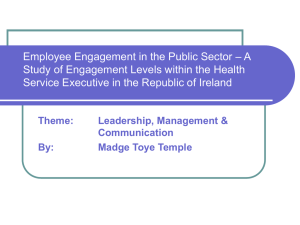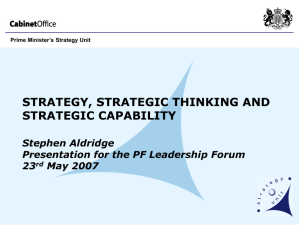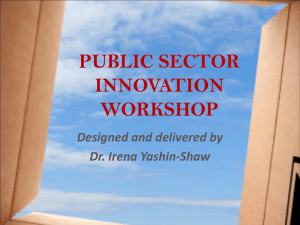Online-Adviser-Presentation-Strategic-Thinking
advertisement
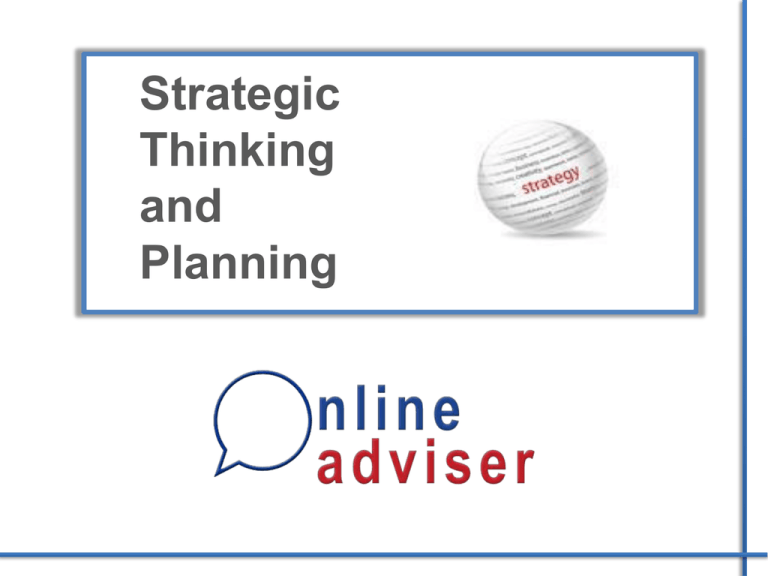
Strategic Thinking and Planning Why think strategically? Studies indicate that: •90% of all businesses lack a strategic plan •Only 19% of workers say they can effectively translate the company’s top goals into the work they do [“The Greatness Challenge,” Franklin Covey] •Businesses that are committed to strategic thinking and planning show an increase of 12% on the bottom line and 11% on the top line, greater above those that don’t do strategic planning. (This is in addition to “business as usual” growth). [Strategic Management Study, by M3 Planning] •You can impact your company’s future and profitability by thinking strategically about your business •The first rule of a successful business strategy is…. Get a business strategy ! [Robert Heller] What is strategy, or strategic thinking? •When you think strategically, you lift your head above your day to day work and consider the larger environment in which you are operating •You ask questions and challenge assumptions about how things work in your company and your industry •A company’s strategic plan is the “game plan” for positioning the company in its chosen market arena, competing successfully, satisfying customers, and achieving good business performance •To move from where you are today to where you want to go, you have to first determine your ‘strategic position’, or where you stand today •You use insights gained to make prudent choices and select appropriate courses of action Gather information... •Collect and effectively analyse information concerning your strategic position, and general trends that might affect your business •The skill to gather data, analyse information, and use the information to improve business processes and efficiencies is an effective strategic thinking skill •Identify patterns in your data that may be useful when developing your strategic plan •Using the S.W.O.T analysis is a trusted business tool for identifying your opportunities and threats S.W.O.T analysis… Conducting a S.W.O.T analysis allows you to: 1. Understand your competitors’ strengths and weaknesses 2. Focus on how you compare to your competitors 3. Identify what activities you need to focus on, and what activities are not necessary 4. Identify what activities you excel at and need to continue to support Does your company have the capabilities to execute its strategy...? •No organisation can successfully execute strategy without the right people, processes and technology capabilities •You need a clear idea of what your capabilities are and where your deficiencies are •Identify and assess capability gaps and the management process required to close the gaps Vision and direction…… 1. 2. 3. 4. 5. Clarify your company direction and purpose Develop a sound strategic vision The strategic vision needs to be realistic, keeping in mind the necessities of the enterprise and what is achievable The goals should be specific and easily measurable Where do you want to be in 3 to 5 years time? Decision-making…… • Use the strategic vision of the company as a basis for all significant decisions • When making decisions, ask the question: Does what we are considering support the company’s strategic vision and direction? Strategic Planning... •The strategic plan is the “bridge” or road map between where the organisation is now and where you want it to be •There are different types of strategic plans at different levels within the organisation Different types of strategic planning at different levels within the organisation External issues Customer perspective Product/Service perspective Price Quantity Availability Selection Functionality Service Brand Internal issues Financial perspective Operational structure Productivity Operations Strategy Customer management Revenue Innovative Growth processes Stategies Regulatory and social processes Learning and Growth Human capital Information capital Organisation capital Learning and Growth Strategy Human Capital >Skills >Training >Knowledge >Collaboration >Roles and responsibilities to align with company goals Information Capital Organisation Capital >Systems >Skills >Databases >Training >Networks >Knowledge >Teamwork Operational Structure How to improve systems and operations Operations Management Processes Customer Management Processes >processes that produce and deliver products and services >processes that enhance customer value Innovative Processes >processes that create new products and services >Creativity and innovative thinking Regulatory and Social Processes >processes that improve communities and the environment Customer/Client Management Processes •Customer management processes cut across all your customers-current and new •When acquiring and serving customers or clients evaluate the following: •Selection – are you identifying the right customers whose problems you can solve? •Acquisition-how many prospects are you turning into customers? •How effective is your marketing strategy? •Retention – are you able to deliver what you promised? •Relationship – are you building on and growing your relationship with your existing customers? Resources •Look at your resources – the assets that your organisation uses to bring revenue into your business .. Intangible Tangible Financial Brand Production facilities: buildings, plants, machinery, capacity, investment, IT resources All items available to finance or pay for your strategic decisions Goodwill Intellectual property Reputation •From a strategic perspective, you need to look at what assets you have vs. what you need to achieve your strategic plan An example of a Strategic Map Sustained shareholder value Financial Perspective Customer Perspective Productivity Strategy Revenue Growth Stategies Improved cost structure Increased asset utilisation Enchance customer value Expand Revenue Opportunities price availability FunctIonality Partnership quantity selection Product/Service attributes Internal Perspective Operations Management Customer Management Processes that Processes that produce and deliver enhance customer products and value services Learning & Growth Perspective service Relationship brand Image Innovative Processes Regulatory & Social Processes Processes that create new products and services Processes that improve communities and the environment Human Capital Information Capital Organisational Capital Skills, training, knowledge Systems, databases, networks Skills, training, knowledge, teamwork On-going monitoring & Implementation •Roll out specific action steps •Ensure that action plans get underway and work gets done •Establish goals and action plans on an annual basis •Management to make a solid commitment to the strategic planning process and to view the process as an “annual tune up” of the company Accountability…… • Accountability and high visibility are needed to help drive change • Each measure, goal, data source and initiative needs to have an owner It’s a discipline, and an on-going process…. •Approach strategic thinking as a discipline — an ongoing process that requires you to make connections between seemingly unrelated things, to think creatively, and then to prioritise and make “trade-offs” •It’s not a linear process, it’s circular, incorporating the driving of continual improvement, and moving the organisation forward towards its vision Summary of the characteristics of successful strategic thinking 1. 2. 3. 4. 5. 6. Seeing opportunity Having a clear vision and direction Engaging in problem-solving Ongoing planning Ongoing monitoring and implementation of the plans Accountability Common mistakes •Confusing marketing with strategy •Pursuing size above all else •Thinking that growth is a strategy •Focusing on high growth markets Benefits of thinking strategically •You chart a course that aligns with the overall strategy of your company •You make careful long-term decisions that complement and align with decisions that others in your organisation are making •You gain your employees' commitment to supporting your decisions •You boost your company's performance and maximise business results •You foster a culture that supports fresh thinking and embraces strategic initiative “There are three types of companies – those that make things happen, those that watch things happen, and those that wonder what happened”Anonymous Presented by: Name of presenter: Position in firm: Firm name: Disclaimer- Whilst every care has been taken in the compilation of this seminar, presentation and handouts, no responsibility of any nature whatsoever shall be accepted for any inaccuracies, errors or omissions, nor for the accuracy of any information contained in the seminar handouts.



